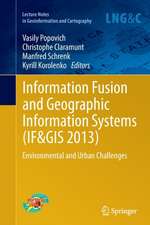Spatial Statistics: GeoSpatial Information Modeling and Thematic Mapping
Autor Mohammed A. Kalkhanen Limba Engleză Hardback – 9 mai 2011
The book explores how to extract information from remotely sensed imagery, GIS, and GPS, and how to combine this with field data—vegetation, soil, and environmental—to produce a spatial model that can be reconstructed and displayed using GIS software. Readers learn the requirements and limitations of each geospatial modeling and mapping tool. Case studies with real-life examples illustrate important applications of the models.
Topics covered in this book include:
- An overview of the geospatial information sciences and technology and spatial statistics
- Sampling methods and applications, including probability sampling and nonrandom sampling, and issues to consider in sampling and plot design
- Fine and coarse scale variability
- Spatial sampling schemes and spatial pattern
- Linear and spatial correlation statistics, including Moran’s I, Geary’s C, cross-correlation statistics, and inverse distance weighting
- Geospatial statistics analysis using stepwise regression, ordinary least squares (OLS), variogram, kriging, spatial auto-regression, binary classification trees, cokriging, and geospatial models for presence and absence data
- How to use R statistical software to work on statistical analyses and case studies, and to develop a geospatial statistical model
Preț: 698.39 lei
Preț vechi: 851.70 lei
-18% Nou
Puncte Express: 1048
Preț estimativ în valută:
133.63€ • 140.27$ • 110.92£
133.63€ • 140.27$ • 110.92£
Carte tipărită la comandă
Livrare economică 10-24 aprilie
Preluare comenzi: 021 569.72.76
Specificații
ISBN-13: 9781420069761
ISBN-10: 1420069764
Pagini: 180
Ilustrații: 51 black & white illustrations, 1 black & white tables
Dimensiuni: 156 x 234 x 15 mm
Greutate: 0.39 kg
Ediția:1
Editura: CRC Press
Colecția CRC Press
ISBN-10: 1420069764
Pagini: 180
Ilustrații: 51 black & white illustrations, 1 black & white tables
Dimensiuni: 156 x 234 x 15 mm
Greutate: 0.39 kg
Ediția:1
Editura: CRC Press
Colecția CRC Press
Public țintă
UndergraduateCuprins
Geospatial Information Technology. Data Sampling Methods and Applications. Spatial Pattern and Correlation Statistics. Geospatial Analysis and Modeling–Mapping. R Statistical Package. Working with Geospatial Information Data. Index.
Notă biografică
Dr. Mohammed A. Kalkhan has over 20 years experience in research and teaching at Colorado State University in Fort Collins, Colorado. As a member of the Natural Resource Ecology Laboratory (NREL) there, he has also served as an affiliate faculty in the Department of Forest, Rangeland, and Watershed Stewardship, and as an advisor for the Interdisciplinary Graduate Certificate in Geospatial Science, Graduate Degree Program in Ecology (GDPE), The School of Global Environmental Sustainability (SOGES), and Department of Earth Resources (currently the Department of Geosciences) at Colorado State University (CSU).
Dr. Kalkhan received his BSc in Forestry (1973) and MSc in Forest Mensuration (1980) from the College of Agriculture and Forestry, the University of Mosul, Iraq. He received his PhD in forest biometrics- remote sensing applications from the Department of Forest Sciences at Colorado State University, USA, in 1994. From 1975 to 1982, he was a lecturer in the Department of Forestry, College of Agriculture and Forestry, University of Mosul. In 1994, he joined the Natural Resource Ecology Laboratory.
Dr. Kalkhan’s main interests are in the integration of field data, remote sensing, and GIS with geospatial statistics to understand landscape parameters through the use of a complex model with thematic mapping approaches, including sampling methods and designs, biometrics, determination of uncertainty and mapping accuracy assessment.
Dr. Kalkhan received his BSc in Forestry (1973) and MSc in Forest Mensuration (1980) from the College of Agriculture and Forestry, the University of Mosul, Iraq. He received his PhD in forest biometrics- remote sensing applications from the Department of Forest Sciences at Colorado State University, USA, in 1994. From 1975 to 1982, he was a lecturer in the Department of Forestry, College of Agriculture and Forestry, University of Mosul. In 1994, he joined the Natural Resource Ecology Laboratory.
Dr. Kalkhan’s main interests are in the integration of field data, remote sensing, and GIS with geospatial statistics to understand landscape parameters through the use of a complex model with thematic mapping approaches, including sampling methods and designs, biometrics, determination of uncertainty and mapping accuracy assessment.
Recenzii
"[This book] covers many topics that are poorly treated by others. ... Chapter 2 on sampling is a true gem. It covers all the standard approaches, but in addition has an extensive discussion of multiphase or double sampling which Kalkhan has used extensively in his own research. There is also an extensive discussion of a case study in which a pixel nested plot (PNP) sampling design is used. This is useful material for researchers and course instructors alike. ... This reviewer enjoyed Chapter 4 immensely. It provides a stimulating discussion of geospatial analysis and modeling including the topics of variogram fitting and kriging. These are pitched at just the right level for most applied researchers who want to use these approaches as a tool to solve their spatial analysis problems. A particular treat is the explanation of spatial autoregressive approaches, binary classification trees and the GARP genetic algorithm. These are topics invariably neglected in many of the standard texts."
—Nigel Waters, Geomatica, Vol. 65, No. 4, 2011
—Nigel Waters, Geomatica, Vol. 65, No. 4, 2011
Descriere
Geospatial information modeling and mapping have become important tools for the investigation and management of natural resources at the landscape scale. This book reviews the types and applications of geospatial information data, such as remote sensing, GIS, and GPS, as well as their integration into landscape-scale geospatial statistical models and maps. Readers will learn the requirements and limitations of each geospatial tool. Along with case studies and statistical data analysis methods, the text includes laboratory exercises using ArcInfo, ArcGIS, ArcView, ERDAS-IMAGINE, and other popular software for geospatial modeling.

























